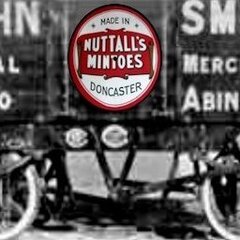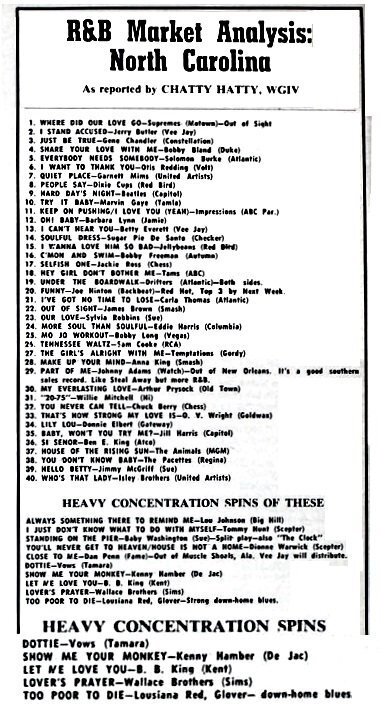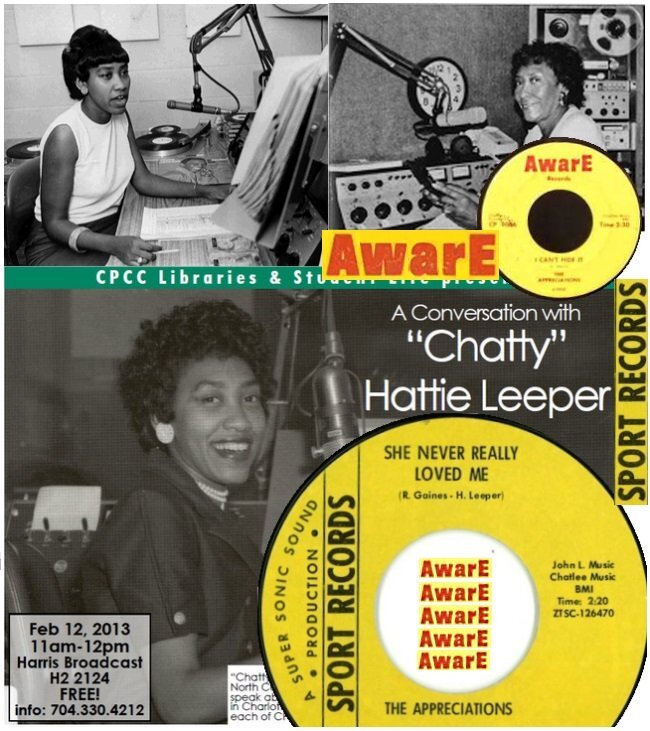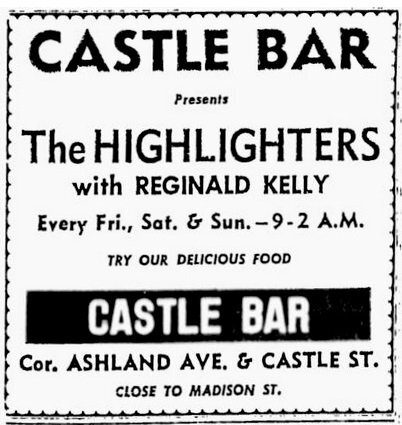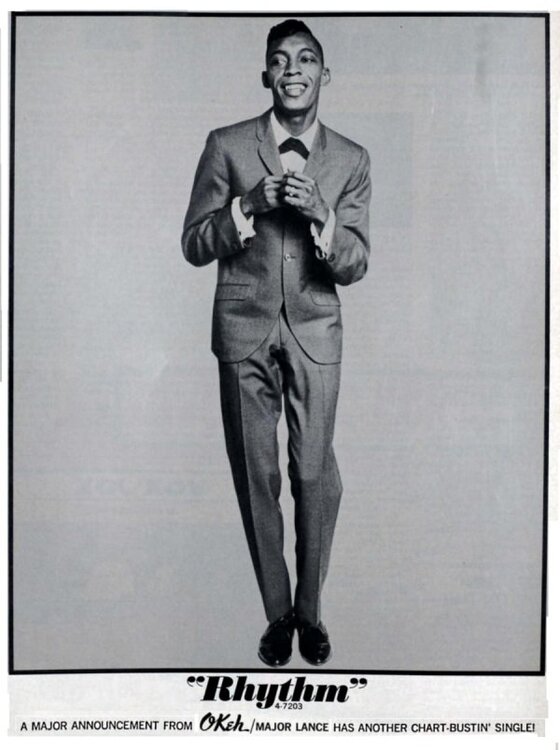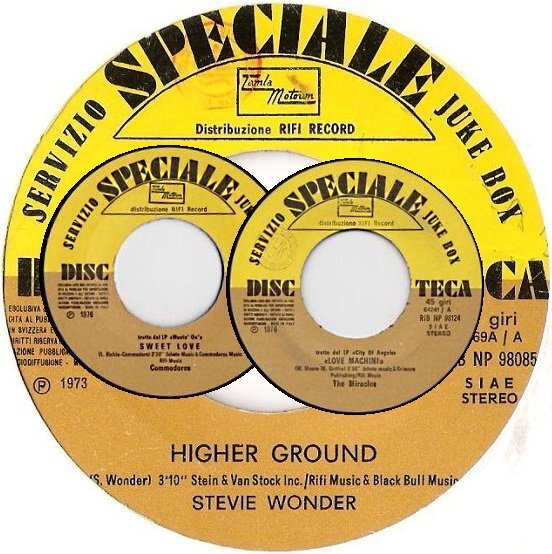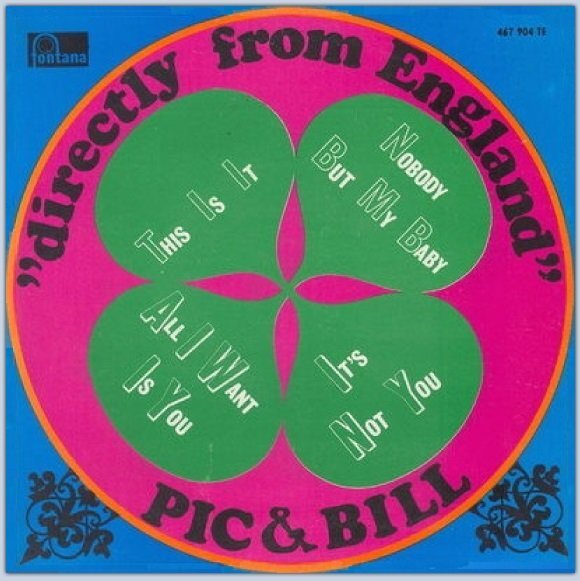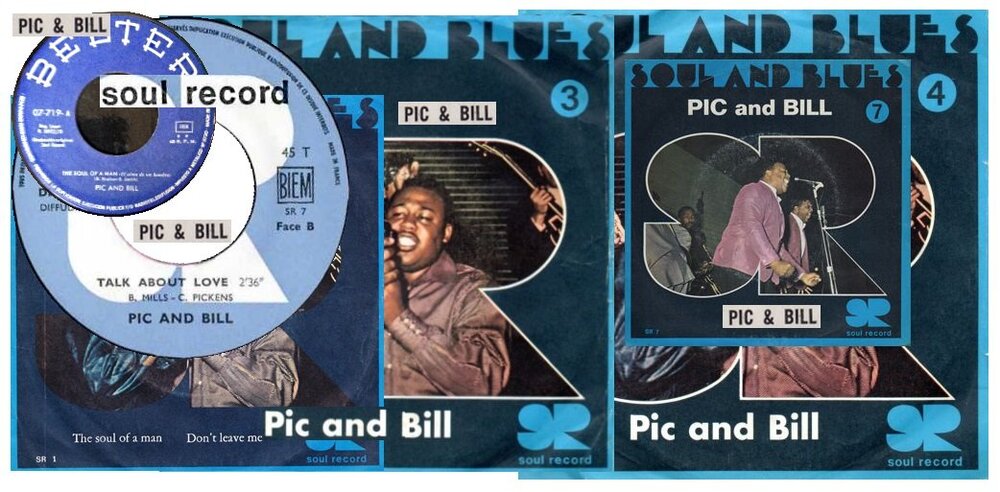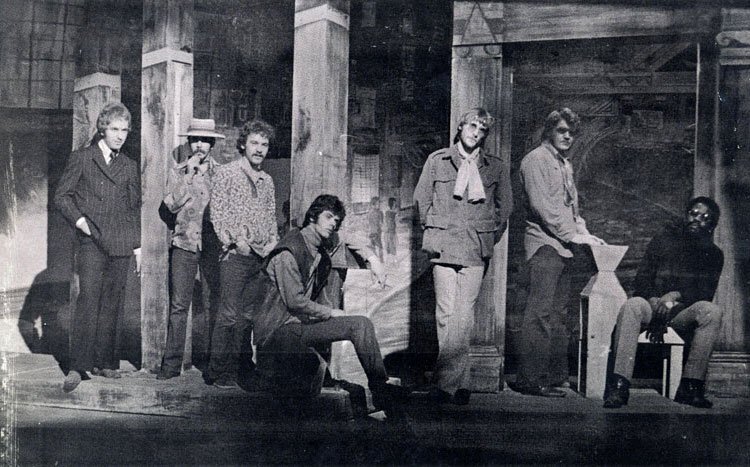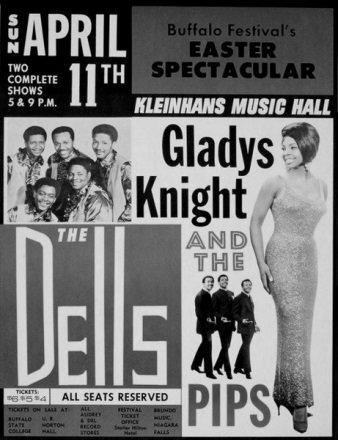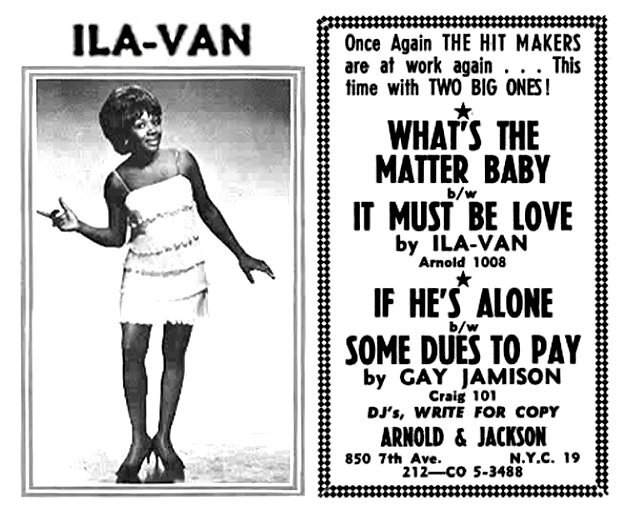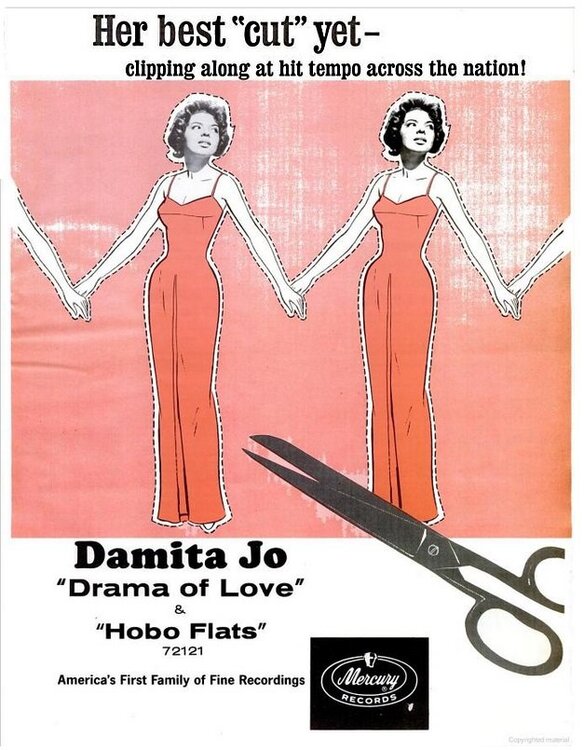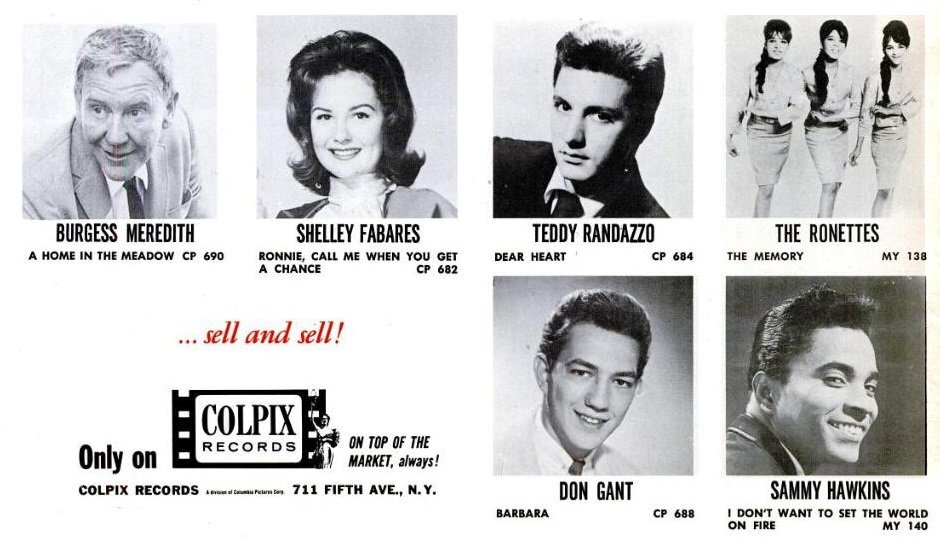Everything posted by Roburt
-
Nothing New Under The Sun
Pete, I'm not trying to start a fight ....... my comment was made as it reads. I'm not trying to re-write ska history. I became interested in Willis Jackson's music career initially via his late 60's / 70's tracks and only learned of the 'influence' of his 1950 Apollo recording later on. Willis started out in the 40's, recorded for the first time at the end of the 40's and led R&B artist backing bands back then. He cut under his own name when signed to Apollo. He went on to make great cuts for the likes of Prestige, Cadet, Verve, Atlantic, Muse & more. He was still recording in 1984. He had backed up Ruth Brown in the 50's and married her. He went then on to tour the chitlin circuit behind the likes of Jackie Wilson. https://www.youtube.com/watch?v=sm0rFfThEGk
-
Chatty Hattie Leeper Wgiv Dj
No, I didn't manage to locate a 'for sale' copy on the net, I've been looking though but without success so far. A copy of a WGIV chart that carries her name ..............
-
Nothing New Under The Sun
Yes, I know he was playing "Later For The Gatur" for years. It became such an anthem that it eventually helped kick off the ska music era (as it heavily influenced many musicians / singers / producers on the scene back then). If you don't wanna accept what I have said .. try this .............. ...... Jamaican ska innovator Prince Buster cites Jackson's song "Later for the Gator" as one of the first ska songs ....... nuff said.
-
Nothing New Under The Sun
The link to the article .............. https://www.dancecrasher.co.uk/interviewsdiscogs/king-edwards/ Been interested in the activities of US saxman / band leader Willis Jackson since I learnt that his 1950 Apollo release "Later For The Gatur" helped kick off the ska boom (after Coxsone Dodd played it on his sound system covered up as "Coxsone's Hop" for many years). https://www.youtube.com/watch?v=-joBISjtQ3M
-
Chatty Hattie Leeper Wgiv Dj
Info on the Tempests ............. https://www.heybabydays.com/Tempests.pdf
-
Chatty Hattie Leeper Wgiv Dj
'Chatty Hattie' of WGIV Radio (Charlotte) was one of the few black women to find a spot in broadcasting in the 1950s. She broke through local convention in North Carolina to be a trendsetter both as a woman and as an African American. 'Chatty Hattie' Leeper’s interest in radio began at an early age. By the time she was fifteen, she was hanging out at radio station WGIV acting as a 'gofor' for the DJ's there. One day, one of the DJ's showed up drunk, crashing his car as he arrived at the station's studio. She had to stand in for him and so began her career playing records on the air. Initially she was too scared to speak much between the records but she soon got over that and became known as 'Chatty Hattie'. After she finished High School she was officially appointed to a DJ's post at the station, making her the first black female DJ at WGIV. She quickly established herself and became a favorite with listeners to her midday slot show. Working at WGIV led to numerous interesting incidents. She got to go out to Otis Redding’s house and spend time with him there. She championed various artists, helping to build up their careers by spinning their records on the air and assisting them on local live shows. Many times when they were booked to play in the Charlotte area, acts would call her to let her know the details. When they arrived locally, she would go to pick them up and take them back to her mother's house (where she was still living). Her mother would cook for them and many were even invited to stay at the house till the show was over and they moved on to their next gig. 'Chatty Hattie' and her fellow DJs also got heavily involved with local community affairs. They would organise shows & make 'pledging appeals' on air to raise funds and get donations of clothes, shoes, etc to hand out to needy black kids. WGIV had been the first local radio station to target black listeners. By the early 60's, lots of white kids in the area were also tuning in to listen to the DJ's there; 'Genial Gene' Potts, 'Joy Boy' Sanders with “Hot Scott” Hubbs (they had the first integrated morning radio show in the South and were the hottest show in town) 'Rockin Ray' Gooding and 'Chatty Hattie' herself. She was the best known and top rated DJ at the station for a period of some years. It was 'Chatty Hattie' that drew up the station's singles chart on many occasions. One such chart she compiled was in August 1964. The Supremes, Jerry Butler, Gene Chandler, Bobby Bland, Solomon Burke, Otis Redding, Garnett Mimms, the Beatles, Marvin Gaye and the Impressions topped it. In addition to their Top 40 chart, the station also selected ten hit picks to play on rotation (calling them their 'Heavy concentration Spins'). In August 1964 one of those singles was Kenny Hamber's “Show Me Your Monkey”. So his track got heavy exposure in North Carolina for a few weeks that summer. WGIV continued to be a cutting edge concern through to 1967. Unfortunately, the owner died that year, the station was sold and the DJ's quit. 'Chatty Hattie' moved on to work at two other local stations but eventually quit the radio business and moved on with her life. But while she was involved with records and artists, she got around to managing a few local acts, writing songs and even running her own record label. Among the acts she helped career wise were the Tempests (Smash Records), Mike Williams (Atlantic Records -- the Tempests backed him up on a few of his tracks) and the Appreciations. The Appreciations even had a 45 released in 1966 on her Aware label which was based out of Charlotte. The group went on to have releases on Jubilee and Sport. The Tempests were a white outfit who featured African American Hazel Martin on lead vocals on many of their tracks. https://www.wsoctv.com/videos/news/chatty-hattie-becomes-americas-first-black-female/vDhJ9/ https://www.youtube.com/watch?v=e_rimuehIPc https://www.youtube.com/watch?v=f9EM48Cv6nI https://www.youtube.com/watch?v=QDkLsAGC5Ak https://www.youtube.com/watch?v=0zGocXJ0qRI Anyone know which studio she used to cut 'her acts' in ? ...... OR ......... anything more about her recording activities ?
-
Clifton Hall
QUESTION .... is Neil Page still around on the scene, I haven't seen him for years & years (though I left the north Nottinghamshire area in 1988).
-
The Highlighters
An ad for a show by the early 60's Baltimore based Highlighters (with Reginald Kelly). I have no idea if this outfit had any connections at all to the group who cut "Chittlin Pot" around 7 years later.
-
U.s. Trade Ads Pictures Record Releases
-
Acapella
You can't beat these guys ....... they did a lot of Motown covers too (on their 70's albums) .... The Persuasions doing CM .... https://www.youtube.com/watch?v=-j1S3l3FgLQ
-
Italian Labels - What You Got ?
-
Italian Labels - What You Got ?
Did some checking & it seems that RIFI was quite a big Italian record company. Most soul stuff they put out though was licensed in from US / UK labels and released under those labels own logos (Tamla Motown, Atlantic, GRC, Contempo, etc.). Anyone know any other soul cuts that actually escaped on the RIFI label itself ??
-
Italian Labels - What You Got ?
The San Remo Song Festival was staged in ..... (WAIT FOR IT) ..... San Remo Italy each year through the 60's & 70's (its still going on I think). Each year, loads of Italian & 'foreign' singers would enter the contest. From the mid 60's through to the 70's, a US soul singer would usually be among the contestants (Wilson Pickett, Dionne Warwick, Timi Yuro, Stevie Wonder, etc.). Most of the acts had to pick a song from that years selected numbers (so then around 3/4 singers would perform each of those songs) plus they performed a song they selected themselves. The organisation that ran the contest had their own 'in-house' label (RIFI) and would release some of the tracks on that label. THEN, if an artists own label wanted to use one of the tracks, they could also release one (or both). Biggest problem with most of the soul tracks were that all the songs were performed in Italian, so the titles / words are a bit unusual. I have the Wilson Pickett effort on the Festivals 'in-house' label + a Stevie Wonder ("Se Tu Ragazza Mia") from the 1969 festival on Spanish Tamla Motown. The Wilson Pickett track is "Un'Avventura" (ain't got my 45 to hand at present to scan the label) which was also from 69 and it escaped as well on an Atlantic label 45 in both Italy & Spain. Don't think the San Remo Golden Strings were ever in the contest though !!!
-
Pic & Bill - Charay 45 Uk / Euro Releases
........... Pic & Bill French 45's ............ Soul Records SR 1 -- The Soul Of a Man / Don't Leave Me Soul Records SR 4 -- This Is My Story / Nobody But My Baby Soul Records SR 5 -- Funny How Time Slips Away / Gonna Give It To You Soul Records SR 7 -- ??? / Talk About Love How many Italian 45 releases did they enjoy (1 ?) and what about their Spanish 7"ers, I know they had at least 1 x 45 + a 7" EP release there (the single being on Belter, the EP on Fontana). Strangely their Fontana EP was identified as being a release that was 'directly from England' so it must have been licensed via Page One.
-
Pic & Bill - Charay 45 Uk / Euro Releases
As a spin off from the Charay based existing thread (Rita Lee) ........... ... thought I'd ask a question or two about Pic & Bill's Charay releases. The duo's 45's were put out in the UK, France, Spain & Italy for sure (how about Germany too ?). My 1st Question is ... anyone know just how many French 45 releases they had ? There were a few put out with similar picture sleeves. Many of the sleeves didn't list the actual tracks on the front but featured a No. instead. I know there were sleeves that had the numbers 3,4 & 7 on them; but were the missing numbers in that series (1, 2, 5, 6, etc) also P&B 45's?
-
Rita Lee?
Quite a few 45's (over the years ) were put out by Major Bill on Charay ............ .... .https://www.globaldogproductions.info/c/charay.html .... https://www.soulfulkindamusic.net/charay.htm Some of the 60's Pic & Bill's got UK releases as did a Berry St Stn 45 in the 70's. Pity more of the label's output didn't escape in the UK.
-
Power Records (Toronto) - La'shell & The Shelletts
The Eric Mercury & the Soul Searchers SAC 45 .... PLUS .... the Grant Smith & the Power 45 cuts on Boo were almost certainly recorded in the same studio (on Don Mills Rd, Toronto) as the La'Shell & the Shelletts tracks. Seems the studio was owned / run by Art Snider & he cut all sorts of stuff there (folk, blues, soul, pop, rock, reggae, novelty items, etc). Two members of the Soul Searchers went on to join the Power around mid 1968 (incidentally the Power's 1st lead singer had been Eddie Spencer). Those two guys were Steve Kennedy (see pic of Grant Smith & the Power below -- he's stood up 3rd from the right) & William Smith (sat on far right). Lots of Grant Smith & the POWER's gigs were advertised as being POWER dances. Also their Boo 45 ads contained the motto 'We Got The POWER'. So I guess members of the outfit could well have been involved with the POWER label that put out the Shelletts cuts in Canada.
-
U.s. Trade Ads Pictures Record Releases
-
Rare Posters (For Soul Acts)
-
U.s. Trade Ads Pictures Record Releases
-
U.s. Trade Ads Pictures Record Releases
-
U.s. Trade Ads Pictures Record Releases
-
Rare Posters (For Soul Acts)
-
U.s. Trade Ads Pictures Record Releases
-
U.s. Trade Ads Pictures Record Releases
Teddy Randazzo is getting lots of mentions across on "the Delfonics Hurt So Bad" thread at present. ........... he's featured on this 1963 Colpix ad when he was still just a singer ............

